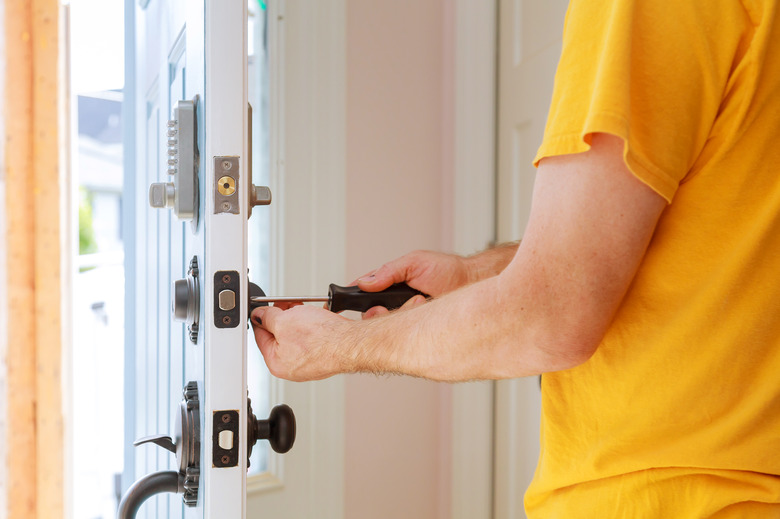The Door Latch Is Stuck And I Can't Shut The Door
We may receive a commission on purchases made from links.
The bad news is that the door latch won't retract when closing the door. The good news is that it's not stuck with the door closed. This makes the removal, cleaning, and repairs and/or replacement of the doorknob or deadbolt easier. If the door was closed, removal of the hardware would be just the start of solving your stuck door problem.
Try a Lubricant
Try a Lubricant
Before completely disassembling the doorknob or deadbolt, try lubrication. Put the WD-40 back on the shelf and pull out the dry graphite lubricant. While WD-40 has many uses, keyholes, doorknobs, and deadbolt locks are better served with a lubricant that doesn't attract dirt, debris, and the occasional ant or earwig into the mechanism.
Put on safety goggles, a mask, and gloves and shoo bystanders, children, and pets away from the doorway. The puff-type graphite is in a squeezable tube, but the spray-type lubricant is carried on an aerosol solvent base. Avoid inhaling or ingesting the product. Do not smoke or use it near any source of flames.
- Puff or spray the dry graphite lubricant into the keyhole and over the key. Insert it into the lock and try to turn it to loosen the door latch.
- Loosen the screws on the mortise plate and doorknob so you can spray the lubricant into the inner mechanism and onto the stuck door latch.
- Turn the doorknob or deadbolt thumb-turn back and forth and tap lightly on the stuck latch to encourage it to retract.
If lubricating the latch and inner mechanism doesn't work, prepare to take off the doorknob. A shoe box is a handy place to deposit the screws and doorknob parts as you remove them from the door.
Clean the Doorknob Parts
Clean the Doorknob Parts
Make it easy to reassemble the doorknob by placing each item in a row as you remove it. Then the parts will be in order when you reassemble the doorknob.
- Remove all the screws from the doorknob and mortise plate.
- Hold onto the knob, as it tends to fall out of the door.
- Wiggle the inner mechanism and spindle to encourage it to disengage from the door latch and remove it.
- Remove the door latch.
Clean your key and each part of the doorknob or deadbolt mechanism with cotton swabs, rubbing alcohol, and clean rags. If the mechanism needs additional cleaning, mineral spirits should remove any oily residue left from previous applications of WD-40 or other lubricants. After cleaning and drying the mechanism, spray all moving parts with the dry graphite lubricant and allow them to dry before reassembling and reinstalling the doorknob or deadbolt.
Replace the Doorknob
Replace the Doorknob
Sometimes, the only solution is to remove and replace the doorknob or deadbolt. While you may be able to repair the doorknob with parts such as Schlage door latch replacement parts, all too often, a complete replacement is the only viable option. Unless your doorknob is an antique and irreplaceable Victorian or Craftsman piece, you can find doorknobs and deadbolts that match your home's style and décor at the local hardware store or online. In addition, vintage and antique doorknobs and other hardware may be found at salvage, specialty, and antique stores as well as online.
Measure the door and existing holes for the knob and latch when searching for new hardware. Schlage hardware, for example, is guaranteed to fit on a standard door prepped with a doorknob hole of 2 1/8 inches, centered 2 3/8 or 2 3/4 inches from the door's edge, and a 7/8- or 1-inch hole for the door latch. Follow the manufacturer's instructions for a successful installation of the new doorknob or deadbolt.
